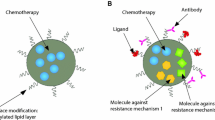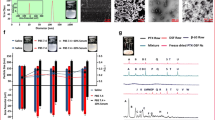Abstract
In this study, the effect of MDR-1 gene silencing, using small interfering RNA (siRNA), and paclitaxel (PTX) co-therapy in overcoming tumor multidrug resistance was examined. Poly(ethylene oxide)-modified poly(beta-amino ester) (PEO-PbAE) and PEO-modified poly(epsilon-caprolactone) (PEO-PCL) nanoparticles were formulated to efficiently encapsulate MDR-1 silencing siRNA and PTX, respectively. Upon administration in multidrug resistant SKOV3TR human ovarian adenocarcinoma cells, siRNA-mediated MDR-1 gene silencing was evident at 100 nM dose. Combination of MDR-1 gene silencing and nanoparticle-mediated delivery significantly influenced the cytotoxic activity of PTX in SKOV3TR cells similar to what was observed in drug sensitive SKOV3 cells. We speculate that the enhancement in cytotoxicity was due to an increase in intracellular drug accumulation upon MDR-1 gene silencing leading to an apoptotic cell-kill effect. Taken together, these preliminary results are highly encouraging for the development of combination nano-therapeutic strategies that combine gene silencing and drug delivery to provide more potent therapeutic effect, especially in refractory tumors.








Similar content being viewed by others
References
Bradley G, Juranka PF, Ling V (1988) Mechanism of multidrug resistance. Biochem Biophys Acta 948:87–128
Desoize B, Jardillier JC (2000) Multicellular resistance: a paradigm for clinical resistance? Crit Rev Oncol Hemat 36:193–207
Szakacs G et al (2006) Targeting multidrug resistance in cancer. Nat Rev Drug Discov 5:219–234
Yusuf RZ et al (2003) Paclitaxel resistance: molecular mechanisms and pharmacologic manipulation. Curr Cancer Drug Targets 3(1):1–19
Gottesman MM, Fojo T, Bates SE (2002) Multidrug resistance in cancer: role of ATP-dependent transporters. Nat Rev Cancer 2:48–58
Harris AL, Hochhauser D (1992) Mechanisms of multidrug resistance in cancer treatment. Acta Oncol 31(2):205–213
Di Nicolantonio F et al (2005) Cancer cell adaptation to chemotherapy. BMC Cancer 5:78
Ganasia-Leymarie V et al (2003) Signal transduction pathways of taxanes-induced apoptosis. Curr Med Chem Anti-Cancer Agents 3(4):291–306
Fire AZ (2007) Gene silencing by double-stranded RNA. Cell Death Differ 14(12):1998–2012
Mello CC, Conte D Jr (2004) Revealing the world of RNA interference. Nature 431(7006):338–342
Elbashir SM et al (2001) Duplexes of 21-nucleotide RNAs mediate RNA interference in cultured mammalian cells. Nature 411(6836):494–498
Elbashir SM, Lendeckel W, Tuschl T (2001) RNA interference is mediated by 21- and 22-nucleotide RNAs. Genes Dev 15(2):188–200
Faltus T et al (2004) Silencing of the HER2/neu gene by siRNA inhibits proliferation and induces apoptosis in HER2/neu-overexpressing breast cancer cells. Neoplasia 6(6):786–795
Oliveira S et al (2007) Photochemical internalization enhances silencing of epidermal growth factor receptor through improved endosomal escape of siRNA. Biochim Biophys Acta 1768(5):1211–1217
Schiffelers RM et al (2004) Cancer siRNA therapy by tumor selective delivery with ligand-targeted sterically stabilized nanoparticle. Nucleic Acids Res 32(19):e149
Hua J, Mutch DG, Herzog TJ (2005) Stable suppression of MDR-1 gene using siRNA expression vector to reverse drug resistance in a human uterine sarcoma cell line. Gynecol Oncol 98(1):31–38
Logashenko EB et al (2004) Silencing of MDR 1 gene in cancer cells by siRNA. Nucleosides Nucleotides Nucleic Acids 23(6–7):861–866
Aagaard L, Rossi JJ (2007) RNAi therapeutics: principles, prospects and challenges. Adv Drug Deliv Rev 59(2–3):75–86
Akhtar S, Benter IF (2007) Nonviral delivery of synthetic siRNAs in vivo. J Clin Invest 117(12):3623–3632
van Vlerken LE, Vyas TK, Amiji MM (2007) Poly(ethylene glycol)-modified nanocarriers for tumor-targeted and intracellular delivery. Pharm Res 24(8):1405–1414
Maeda H et al (2000) Tumor vascular permeability and the EPR effect in macromolecular therapuetics: a review. J Control Rel 65(1–2):271–284
Monsky WL et al (1999) Augmentation of transvascular transport of macromolecules and nanoparticles in tumors using vascular endothelial growth factor. Cancer Res 59(16):4129–4135
Chawla JS, Amiji MM (2002) Biodegradable poly(epsilon-caprolactone) nanoparticles for tumor-targeted delivery of tamoxifen. Int J Pharm 249(1–2):127–138
Chawla JS, Amiji MM (2003) Cellular uptake and concentrations of tamoxifen upon administration in poly(epsilon-caprolactone) nanoparticles. AAPS Pharmsci 5(1):E3
Devalapally H et al (2007) Paclitaxel and ceramide co-administration in biodegradable polymeric nanoparticulate delivery system to overcome drug resistance in ovarian cancer. Int J Cancer 121:1830–1838
Shenoy DB, Amiji MM (2005) Poly(ethylene oxide)-modified poly(epsilon caprolactone) nanoparticles for targeted delivery of tamoxifen in breast cancer. Int J Pharm 293:261–270
van Vlerken LE et al (2007) Modulation of intracellular ceramide using polymeric nanoparticles to overcome multidrug resistance in cancer. Cancer Res 67(10):4843–4850
Zugates GT et al (2007) Gene delivery properties of end-modified poly(beta-amino ester)s. Bioconjug Chem 18(6):1887–1896
Anderson DG et al (2005) Structure/property studies of polymeric gene delivery using a library of poly(beta-amino esters). Mol Ther 11(3):426–434
Devalapally H et al (2006) Poly(ethylene oxide)-modified poly(beta-amino ester) nanoparticles as a pH-sensitive system for tumor-targeted delivery of hydrophobic drugs: part 3. Therapeutic efficacy and safety studies in ovarian cancer xenograft model. Cancer Chemother Pharmacol [Epub]
Shenoy D et al (2005) Poly(ethylene oxide)-modified poly(beta amino ester) nanoparticles as a pH sensitive system for tumor-targeted delivery of hydrophobic drugs: part 2. In vivo distribution and tumor localization studies. Pharm Res 22(12):2107–2114
Shenoy D et al (2005) Poly(ethylene oxide)-modified poly(beta amino ester) nanoparticles as a pH-sensitive system for tumor-targeted delivery of hydrophobic drugs. Part I. Invitro evaluations. Mol Pharmaceutics 2(5):357–366
Wu H, Hait WN, Yang JM (2003) Small interfering RNA-induced suppression of MDR1 (P-glycoprotein) restores sensitivity to multidrug-resistant cancer cells. Cancer Res 63(7):1515–1519
Dordunoo SK et al (1995) Taxol encapsulation in poly(epsilon-caprolactone) microspheres. Cancer Chemother Pharmacol 36(4):279–282
Duan Z et al (2005) Description of paclitaxel resistance-associated genes in ovarian and breast cancer cell lines. Cancer Chemo Pharm 55:277–285
Duan Z, Brakora KA, Seiden MV (2004) Inhibition of ABCB1 (MDR1) and ABCB4 (MDR3) expression by small interfering RNA and reversal of paclitaxel resistance in human ovarian cancer cells. Mol Cancer Ther 3(7):833–838
Acknowledgments
This study was supported by the Nanotechnology Platform Partnership grant (R01-CA119617) from the National Cancer Institute (NCI) of the U.S. National Institutes of Health. We deeply appreciate the assistance of Professor Robert Campbell and his lab members with the particle size, surface charge, and optical microscopy studies. Scanning electron microscopy was performed by Mr. William Fowle at the Electron Microscopy Center, Northeastern University (Boston, MA).
Author information
Authors and Affiliations
Corresponding author
Rights and permissions
About this article
Cite this article
Yadav, S., van Vlerken, L.E., Little, S.R. et al. Evaluations of combination MDR-1 gene silencing and paclitaxel administration in biodegradable polymeric nanoparticle formulations to overcome multidrug resistance in cancer cells. Cancer Chemother Pharmacol 63, 711–722 (2009). https://doi.org/10.1007/s00280-008-0790-y
Received:
Accepted:
Published:
Issue Date:
DOI: https://doi.org/10.1007/s00280-008-0790-y




